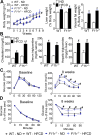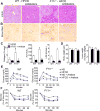Loss of Junctional Adhesion Molecule A Promotes Severe Steatohepatitis in Mice on a Diet High in Saturated Fat, Fructose, and Cholesterol
- PMID: 27342212
- PMCID: PMC5037035
- DOI: 10.1053/j.gastro.2016.06.022
Loss of Junctional Adhesion Molecule A Promotes Severe Steatohepatitis in Mice on a Diet High in Saturated Fat, Fructose, and Cholesterol
Abstract
Background & aims: There is evidence from clinical studies that compromised intestinal epithelial permeability contributes to the development of nonalcoholic steatohepatitis (NASH), but the exact mechanisms are not clear. Mice with disruption of the gene (F11r) encoding junctional adhesion molecule A (JAM-A) have defects in intestinal epithelial permeability. We used these mice to study how disruption of the intestinal epithelial barrier contributes to NASH.
Methods: Male C57BL/6 (control) or F11r(-/-) mice were fed a normal diet or a diet high in saturated fat, fructose, and cholesterol (HFCD) for 8 weeks. Liver and intestinal tissues were collected and analyzed by histology, quantitative reverse-transcription polymerase chain reaction, and flow cytometry. Intestinal epithelial permeability was assessed in mice by measuring permeability to fluorescently labeled dextran. The intestinal microbiota were analyzed using 16S ribosomal RNA sequencing. We also analyzed biopsy specimens from proximal colons of 30 patients with nonalcoholic fatty liver disease (NAFLD) and 19 subjects without NAFLD (controls) undergoing surveillance colonoscopy.
Results: F11r(-/-) mice fed a HFCD, but not a normal diet, developed histologic and pathologic features of severe NASH including steatosis, lobular inflammation, hepatocellular ballooning, and fibrosis, whereas control mice fed a HFCD developed only modest steatosis. Interestingly, there were no differences in body weight, ratio of liver weight:body weight, or glucose homeostasis between control and F11r(-/-) mice fed a HFCD. In these mice, liver injury was associated with significant increases in mucosal inflammation, tight junction disruption, and intestinal epithelial permeability to bacterial endotoxins, compared with control mice or F11r(-/-) mice fed a normal diet. The HFCD led to a significant increase in inflammatory microbial taxa in F11r(-/-) mice, compared with control mice. Administration of oral antibiotics or sequestration of bacterial endotoxins with sevelamer hydrochloride reduced mucosal inflammation and restored normal liver histology in F11r(-/-) mice fed a HFCD. Protein and transcript levels of JAM-A were significantly lower in the intestinal mucosa of patients with NAFLD than without NAFLD; decreased expression of JAM-A correlated with increased mucosal inflammation.
Conclusions: Mice with defects in intestinal epithelial permeability develop more severe steatohepatitis after a HFCD than control mice, and colon tissues from patients with NAFLD have lower levels of JAM-A and higher levels of inflammation than subjects without NAFLD. These findings indicate that intestinal epithelial barrier function and microbial dysbiosis contribute to the development of NASH. Restoration of intestinal barrier integrity and manipulation of gut microbiota might be developed as therapeutic strategies for patients with NASH.
Keywords: Bacterial Translocation; Claudin-4; Occludin.
Copyright © 2016 AGA Institute. Published by Elsevier Inc. All rights reserved.
Conflict of interest statement
All authors declare no conflicting interests.
Figures







Similar articles
-
Blocking integrin α4β7-mediated CD4 T cell recruitment to the intestine and liver protects mice from western diet-induced non-alcoholic steatohepatitis.J Hepatol. 2020 Nov;73(5):1013-1022. doi: 10.1016/j.jhep.2020.05.047. Epub 2020 Jun 12. J Hepatol. 2020. PMID: 32540177 Free PMC article.
-
Western diet-induced increase in colonic bile acids compromises epithelial barrier in nonalcoholic steatohepatitis.FASEB J. 2020 May;34(5):7089-7102. doi: 10.1096/fj.201902687R. Epub 2020 Apr 10. FASEB J. 2020. PMID: 32275114 Free PMC article.
-
Microbiota-driven gut vascular barrier disruption is a prerequisite for non-alcoholic steatohepatitis development.J Hepatol. 2019 Dec;71(6):1216-1228. doi: 10.1016/j.jhep.2019.08.005. Epub 2019 Aug 13. J Hepatol. 2019. PMID: 31419514 Free PMC article.
-
The current findings on the gut-liver axis and the molecular basis of NAFLD/NASH associated with gut microbiome dysbiosis.Naunyn Schmiedebergs Arch Pharmacol. 2025 Apr 9. doi: 10.1007/s00210-025-04069-z. Online ahead of print. Naunyn Schmiedebergs Arch Pharmacol. 2025. PMID: 40202676 Review.
-
Intestinal permeability in human nonalcoholic fatty liver disease: A systematic review and meta-analysis.Liver Int. 2020 Dec;40(12):2906-2916. doi: 10.1111/liv.14696. Epub 2020 Oct 21. Liver Int. 2020. PMID: 33037768 Free PMC article.
Cited by
-
The Role of the Gut-Liver Axis in Metabolic Dysfunction-Associated Fatty Liver Disease.Front Immunol. 2021 Apr 16;12:660179. doi: 10.3389/fimmu.2021.660179. eCollection 2021. Front Immunol. 2021. PMID: 33936094 Free PMC article. Review.
-
Gut microbiota, fatty liver disease, and hepatocellular carcinoma.Liver Res. 2018 Mar;2(1):43-51. doi: 10.1016/j.livres.2017.11.005. Epub 2018 Feb 21. Liver Res. 2018. PMID: 30416839 Free PMC article.
-
Novel Biomarker Establishment for Evaluation of Excessive Fructose Consumption Using a Rat Model.In Vivo. 2023 Jan-Feb;37(1):173-181. doi: 10.21873/invivo.13066. In Vivo. 2023. PMID: 36593010 Free PMC article.
-
The Role of the Gastrointestinal Microbiome in Liver Disease.Pathogens. 2023 Aug 27;12(9):1087. doi: 10.3390/pathogens12091087. Pathogens. 2023. PMID: 37764895 Free PMC article. Review.
-
Glucose but Not Fructose Alters the Intestinal Paracellular Permeability in Association With Gut Inflammation and Dysbiosis in Mice.Front Immunol. 2021 Dec 27;12:742584. doi: 10.3389/fimmu.2021.742584. eCollection 2021. Front Immunol. 2021. PMID: 35024040 Free PMC article.
References
-
- Mahady SE, George J. Management of nonalcoholic steatohepatitis: an evidence-based approach. Clin Liver Dis. 2012;16:631–45. - PubMed
-
- Williams CD, Stengel J, Asike MI, et al. Prevalence of nonalcoholic fatty liver disease and nonalcoholic steatohepatitis among a largely middle-aged population utilizing ultrasound and liver biopsy: a prospective study. Gastroenterology. 2011;140:124–31. - PubMed
-
- Miele L, Valenza V, La Torre G, et al. Increased intestinal permeability and tight junction alterations in nonalcoholic fatty liver disease. Hepatology. 2009;49:1877–87. - PubMed
-
- Lorenzo-Zuniga V, Bartoli R, Planas R, et al. Oral bile acids reduce bacterial overgrowth, bacterial translocation, and endotoxemia in cirrhotic rats. Hepatology. 2003;37:551–7. - PubMed
Publication types
MeSH terms
Substances
Grants and funding
LinkOut - more resources
Full Text Sources
Other Literature Sources
Medical
Molecular Biology Databases

